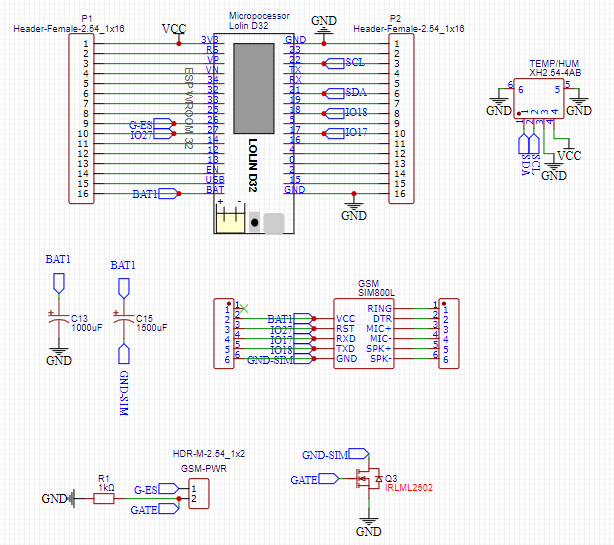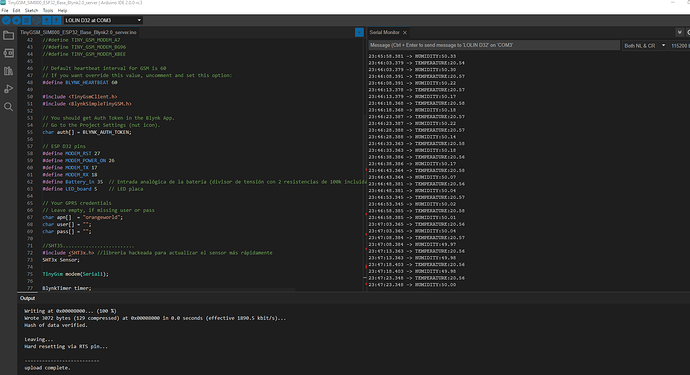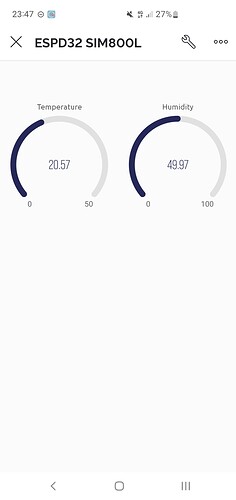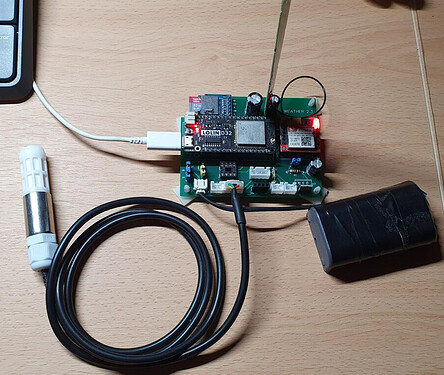Hi @KazaDoor,
You can find below a working example using the EspD32 + Sim800L + SHT35.
Adapt this basic code to your needs as I’m using the EspD32 rather than the Nodemcu…
Keep in mind that, in my case, VCC for SIM800L is managed by a MOSFET.
/*************************************************************
Download latest Blynk library here:
https://github.com/blynkkk/blynk-library/releases/latest
Blynk is a platform with iOS and Android apps to control
Arduino, Raspberry Pi and the likes over the Internet.
You can easily build graphic interfaces for all your
projects by simply dragging and dropping widgets.
Downloads, docs, tutorials: http://www.blynk.cc
Sketch generator: http://examples.blynk.cc
Blynk community: http://community.blynk.cc
Follow us: http://www.fb.com/blynkapp
http://twitter.com/blynk_app
Blynk library is licensed under MIT license
This example code is in public domain.
*************************************************************
Attention! Please check out TinyGSM guide:
https://tiny.cc/tinygsm-readme
Change GPRS apm, user, pass, and Blynk auth token to run :)
Feel free to apply it to any other example. It's simple!
*************************************************************/
/* Comment this out to disable prints and save space */
#define BLYNK_PRINT Serial
#define BLYNK_TEMPLATE_ID "mmmmmmmmmm"
#define BLYNK_DEVICE_NAME "ESPD32 SIM800L"
#define BLYNK_AUTH_TOKEN "nnnnnnnnnnnnnn"
#define BLYNK_TIMEOUT_MS 30000UL
// Select your modem:
#define TINY_GSM_MODEM_SIM800
//#define TINY_GSM_MODEM_SIM900
//#define TINY_GSM_MODEM_M590
//#define TINY_GSM_MODEM_A6
//#define TINY_GSM_MODEM_A7
//#define TINY_GSM_MODEM_BG96
//#define TINY_GSM_MODEM_XBEE
// Default heartbeat interval for GSM is 60
// If you want override this value, uncomment and set this option:
#define BLYNK_HEARTBEAT 60
#include <TinyGsmClient.h>
#include <BlynkSimpleTinyGSM.h>
// You should get Auth Token in the Blynk App.
// Go to the Project Settings (nut icon).
char auth[] = BLYNK_AUTH_TOKEN;
// ESP D32 pins
#define MODEM_RST 27
#define MODEM_POWER_ON 26
#define MODEM_TX 17
#define MODEM_RX 18
#define Battery_in 35
#define LED_board 5 // LED placa
// Your GPRS credentials
// Leave empty, if missing user or pass
char apn[] = "orangeworld";
char user[] = "";
char pass[] = "";
//SHT35.........................
#include <SHT3x.h>
SHT3x Sensor;
TinyGsm modem(Serial1);
BlynkTimer timer;
void setup()
{
// Debug console
Serial.begin(115200);
delay(10);
Sensor.Begin(); //sht3x
pinMode(Battery_in, INPUT);
pinMode(LED_board, OUTPUT); // LED placa
digitalWrite(LED_board, HIGH); // Apago el LED de la PLACA
pinMode(MODEM_RST, OUTPUT);
pinMode(MODEM_POWER_ON, OUTPUT);
digitalWrite(MODEM_RST, HIGH);
digitalWrite(MODEM_POWER_ON, HIGH);
// Set GSM module baud rate
//Serial1.begin(9600);
Serial1.begin(115200, SERIAL_8N1, MODEM_RX, MODEM_TX);
delay(3000);
// Restart takes quite some time
// To skip it, call init() instead of restart()
Serial.println("Initializing modem...");
modem.init();
//modem.restart();
// Unlock your SIM card with a PIN
//modem.simUnlock("1234");
// Blynk.begin(auth, modem, apn, user, pass);
Blynk.config(modem, auth);
Blynk.connectNetwork(apn, user, pass);
timer.setInterval(5000L, CHECK_SENSOR); // Check sensor
}
void CHECK_SENSOR()
{
Sensor.UpdateData();
float temp = Sensor.GetTemperature();
float hum = Sensor.GetRelHumidity();
Blynk.virtualWrite(V0, temp);
Blynk.virtualWrite(V1, hum);
Serial.print("TEMPERATURE:");
Serial.println(temp);
Serial.print("HUMIDITY:");
Serial.println(hum);
}
void loop()
{
Blynk.run();
timer.run();
}
Hope this helps…
Regards



